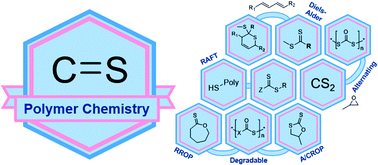Thiocarbonyl chemistry in polymer science
Abstract
Organised by reaction type, this review highlights the unique reactivity of thiocarbonyl (C![[double bond, length as m-dash]](https://www.rsc.org/images/entities/char_e001.gif) S) groups with radicals, anions, nucleophiles, electrophiles, in pericyclic reactions, and in the presence of light. In the polymer chemistry arena, thiocarbonyl compounds have been used as monomers, polymerization catalysts, reversible and irreversible chain transfer agents, and in post-polymerization modification reactions. Past and ongoing applications are reviewed including iniferters, radical and cationic RAFT, switchable RAFT agents, cyclic RAFT agents, chain transfer, thiocarbonyl addition-ring-opening, C
S) groups with radicals, anions, nucleophiles, electrophiles, in pericyclic reactions, and in the presence of light. In the polymer chemistry arena, thiocarbonyl compounds have been used as monomers, polymerization catalysts, reversible and irreversible chain transfer agents, and in post-polymerization modification reactions. Past and ongoing applications are reviewed including iniferters, radical and cationic RAFT, switchable RAFT agents, cyclic RAFT agents, chain transfer, thiocarbonyl addition-ring-opening, C![[double bond, length as m-dash]](https://www.rsc.org/images/entities/char_e001.gif) S radical and anionic polymerization, acyl substitution, cationic, anionic/organo-catalytic ring-opening, Diels–Alder additions, thermolysis, and photo reactions. The review discusses the mechanisms of these reactions and highlights how the reactivity differs from oxocarbonyl analogues. Emphasis is put on the development of novel thiocarbonyl monomers which, uniquely, undergo polymerization through different mechanisms.
S radical and anionic polymerization, acyl substitution, cationic, anionic/organo-catalytic ring-opening, Diels–Alder additions, thermolysis, and photo reactions. The review discusses the mechanisms of these reactions and highlights how the reactivity differs from oxocarbonyl analogues. Emphasis is put on the development of novel thiocarbonyl monomers which, uniquely, undergo polymerization through different mechanisms.

- This article is part of the themed collection: Polymer Chemistry Most Popular 2022


 Please wait while we load your content...
Please wait while we load your content...